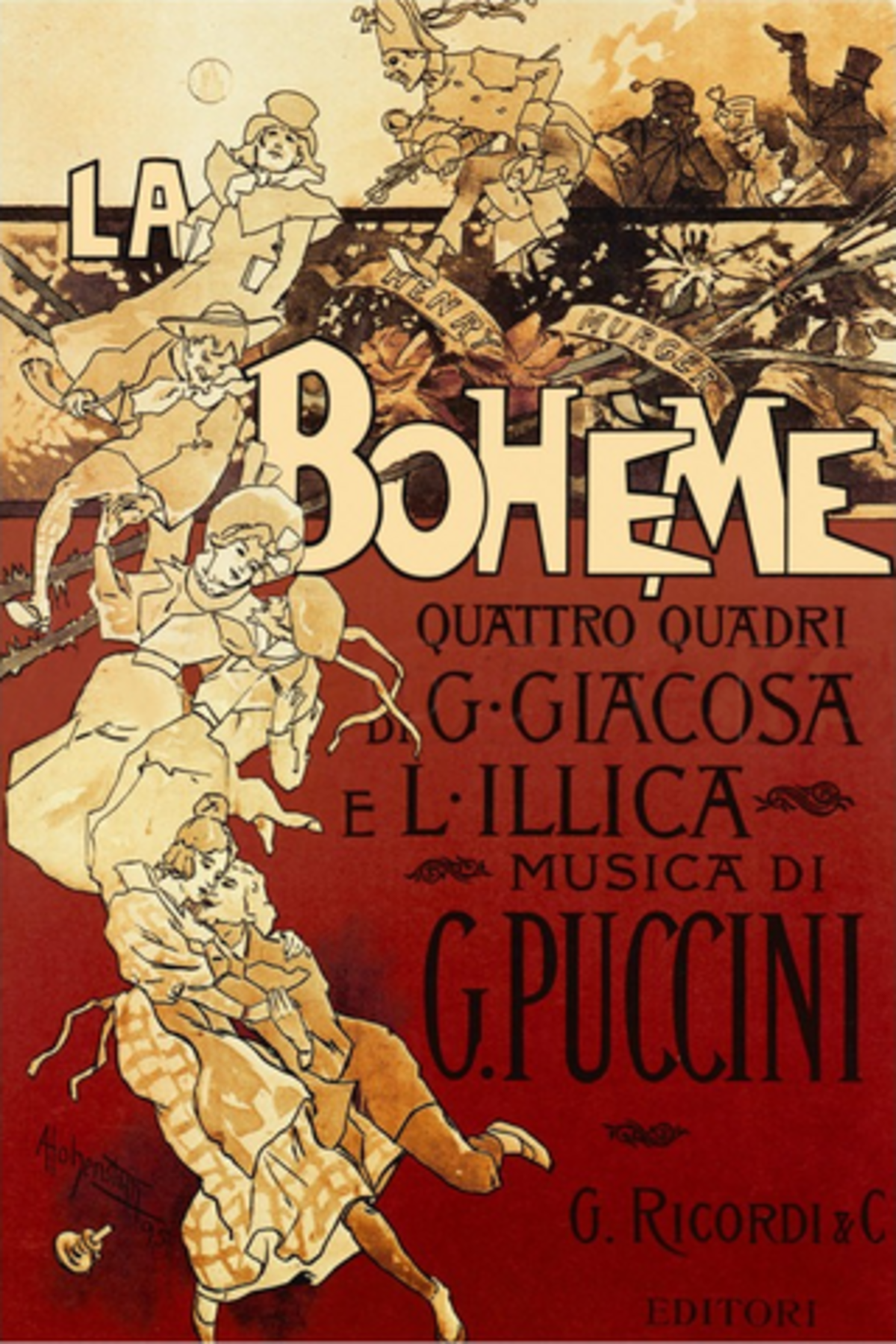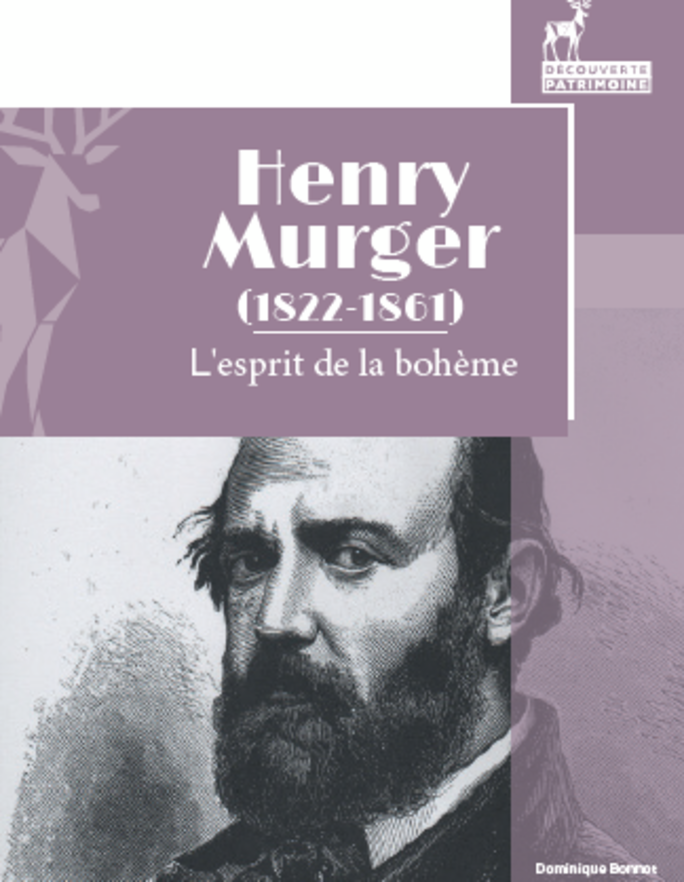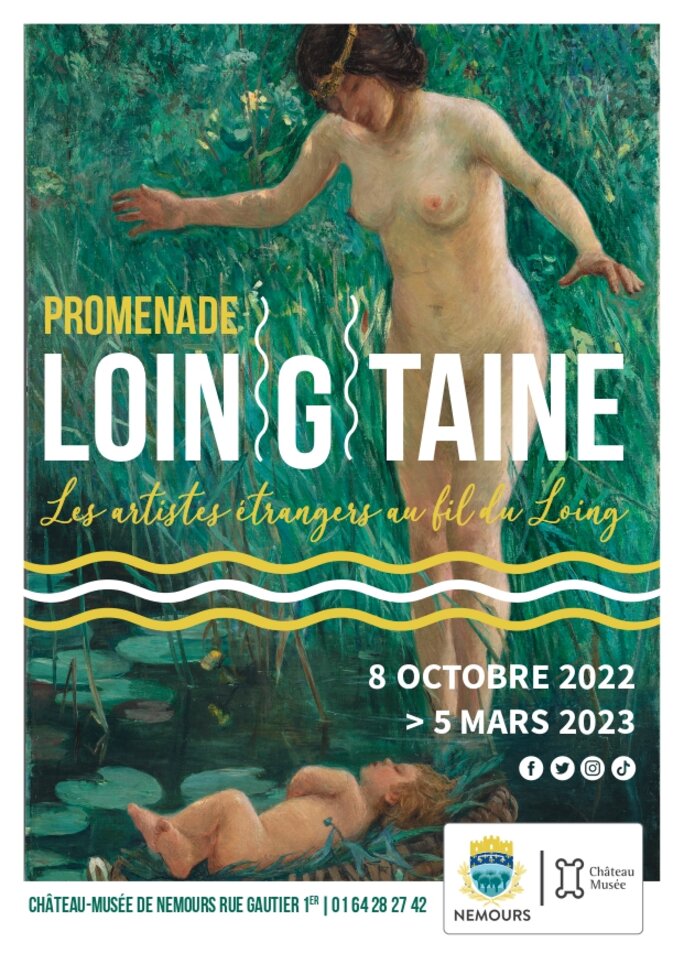THE BOHÈME IN BOIS LE ROI. ART, POLITICS AND NATURALISM
Mimi’s aria, the seamstress heroin of La Bohème, Giacomo Puccini ‘s opera created at la Scala in Milan in 1896, Mi chiamano Mimi, is famous all over the world, yet few still remember in the bicentenary year of his birth the creator of the Scènes de la vie de Bohème, Henry Murger (1822-1861), poet and playwright, secretary to Count Tolstoy Champfleury wrote a chapter on him in 1872 in his Souvenirs et portraits de jeunesse, Youthful portraits and Recollections : « … the rumor had spread that a future vaudeville writer had just arrived in a furnished hotel in the Quartier Latin, where he would provide dinner to famished stomachs…Murger was then in all his splendour : altogether painter, poet, secretary to a grand Russian personality, he dazzled his friends with the amazing splendour of his apartment at the Tour-d’Auvergne. This apartment was an attic ; but there magnificent dramas were read aloud and their verses embellished the walls.

Murger did not invent the word Bohème, the definition of the Bohemian in its social connotation is due to Gédéon Tallemant des Réaux, the Huguenot cousin by marriage of the Italian-born marquise de Rambouillet, in whose famous Parisian salon reigned Horace’s spirit: Poetry must please or educate. In 1669 in his HistoriettesTallemant des Réaux coined the word Bohemien in order to differentiate people of wit from those dominated by fashion and the absolute authority of the King, whether at Court or in Parisian circles. A Bohemian is a free spirit on the fringe of society, who stands out from others, not only through his critical and enlightened mind, but by his way of life and of dressing.
Honoré de Balzac took in 1844 Tallemant des Réaux’s 1669 definition in his short story: A Prince in Bohemia. The name « bohemian » tells you everything. The bohemian has nothing and lives on his wits. The Scènes de la vie de Bohème, were first published from 1845 onwards as a serial in the satirical paper, Le Corsaire Satan, in which the young Baudelaire published his first writings. In 1849, in collaboration with Théodore Barrière, the play La Vie de bohème brought success Murger, and the book La vie de Bohème, published in 1851 and in 1858 with illustrations by André Gill, made the concept popular. Bohemian life is poor in wordily possessions, but rich in freedom, poetic and artistic creativity, sensuality, and true happiness in its integrity of aspirations and feelings. Arthur Rimbaud, who after François Villon is the quintessential wandering French poet, became its bard in his poem: Ma Bohème. Beaudelaire was inspired by Jacques Callot’s 17th century engravings and sang the Prophetic tribe with flashing eyes, in Les Fleurs du Mal.
Under the effects of the Industrial Revolution at the end of the 18th , and at the beginning of the 19th century in England, the figure of the Gypsy became identified with that of a man still free and independent in a society increasingly urbanized. William Blake’s Satanic mills were invading the countryside, destroying forever rural England’s pleasant pastures and mountains green. In Regency and Puritan Victorian England, the Gypsy was depicted in children’s books as a wicked chicken and children robber. In the novels of the time, the Gypsycharacter stood for the freeing from the rigid principles ruling a stifling, materialistic and moralizing bourgeois society. It does seem that from the time of their arrival in Europe, the Egyptians, the Bohemians, the Gitans, the Gypsies, have played an essential part as a social catalyst. They have always stood for an alternative way of life, broader, freer and richer in rewards, than that of the city-dwellers stifled by their wordily possessions, their ambitions, their fears and their narrow morality. In fact, the freedom offered by the Gypsies is a challenge to people living in industrialized cities. It brings them face to face with themselves, and as in a mirror, makes them confront their own image. Will they be able to use the glimpsed freedom for the better, or will they fall back into their past errors?
In the philosophical and existentialist sense, the Bohemians, the Gitans, the Gypsies, have become the conscience of the city’s dwellers. They were already their forgotten memory through the history of their ancient past, wandering from East to West. Murger was fully aware of it when in his book he speaks of the Bohèmes’s ideal as «…the Gospel parable, which should be mankind’s sole charter: ‘Support and love each other’. » He describes the Bohèmes’s sense of beauty, the soft heart, the humour and lighthearted spirit, the essence of happiness and joie-de-vivre: « …they all had the same comical sparring spirit, amusing without being offensive, and their hearts were filled with all the beautiful youthful virtues, easily moved by the sight or the story of a beautiful thing. » If Murger in his Scènes de la vie de Bohème uses a theme and a form of storytelling popular in the 1840’s in a comedy of manners describing the lives of students and shop girls, poets and artists, among other actors on the Parisian scene, and although youth seems to be a condition, he adds to it a new philosophical dimension and an art of living : a Bohème is « any man who practices any one of the arts, without any other means of living than the arts themselves. »
In the Anglo-Saxon world the word Bohemian was used for the first time in 1848, an echo of Murger’s work, in William Makepeace Thackeray’s novel Vanity Fair, 1847-48, subtitled A novel without a hero. To Murger’s reactionary creative and artistic Parisian life, its sensuality and joie de vivre, Thackeray opposed the moralizing puritanism of Victorian England. He denounced the mean-minded, hypocritical and opportunist Victorian society in a cynical satire far removed from the French romantic heroic concept of the Dandy exemplified by Baudelaire. In 1862, the Westminster Review defines thus the Bohemian: The term Bohemian has come to be very commonly accepted in our day as the description of a certain kind of literary gypsy, no matter in what language he speaks, or what city he inhabits .... A Bohemian is simply an artist or "littérateur" who, consciously or unconsciously, secedes from conventionality in life and in art. In 1894 the novel of George du Maurier novel, Trilby, tells the adventures of three English artists and their Irish model in their Parisian exile. Bohemian life first flourished in the 19th century in Paris in the miserable attics of the Quartier Latin. At the beginning of the 20th century it moved to the artists ‘studios in the Montparnasse district and in Montmartre, such as theBateau-Lavoir, where poets and artists lived or visited, from Gauguin to Picasso, Modigliani, Max Jacob, Brancusi and Le Douanier Rousseau. In London, Bohemian life settled in Chelsea, Soho and the Fitzrovia of the Bloomsbury set, to which belonged the playwriter George Bernard Shaw, the Welsh poet Dylan Thomas, the painter Wyndham Lewis, the writer Virginia Woolf, and the economist John Maynard Keynes. The French poets Arthur Rimbaud and Paul Verlaine joined them for a while, living in Howland Street in Camden Town.
American Bohemianism came into existence around 1848 under the influence of French literature. In 1857 a group of young and cultured journalists called themselves Bohemians, and during the Civil War, 1861-65, war correspondents were thus named. In 1861 in San Francisco, Brett Harte, journalist, author and poet, took on the penname The Bohemian. In 1867 he wrote in the Bohemian Papers : Bohemia has never been located geographically, but any clear day when the sun is going down, if you mount Telegraph Hill, you shall see its pleasant valleys and cloud-capped hills glittering in the West... Mark Twain, the well-travelled author also claims to be a Bohemian in 1867. The name was then applied to a social and intellectual intellitgensia according to the definition of the George Sterling : There are two elements, at least, that are essential to Bohemianism. The first is devotion or addiction to one or more of the Seven Arts; the other is poverty… In 1872 The Bohemian Club was created in San Francisco and the members included journalists, artists, poets and musicians. Since that date Bohemianism in the country of capitalism and liberalism has become middle and upper class. Businessmen, politicians, and self-made men, all belong to the Club, it has now become a place of conviviality for sports lovers and art collectors, where artists are a minority, and doubtless the poor are excluded.
In France the Bohème had several phases. To « Murger’s smoky Bohème » in the attics and cafés of the Quartier Latin in Paris, succeeded a bucolic one at Bourron-Marlotte, a village south of Fontainebleau discovered by Murger in 1850. Since 1830, following Corot’s lead, some artists had settled there to paint in plein-air, soon joined by some other painters from Barbizon. Murger introduced his poets and writers friends to the village, among them Théodore de Banville, Alfred de Musset and his brother Paul, as well as Théophile Gautier, friend of the Dr. Jacques-Joseph Moreau de Tours, the famous psychiatrist and father of the the painter Georges Moreau de Tours. Gauthier was attending the soirées at the Hôtel Lauzun in Paris, where Baudelaire lived, of the Club des Hashishins created by the psychiatrist, which he described in 1848 in his eponymous essay. The Forest of Fontainebleau’s wild and natural beauty had been revealed in 1839 by a former sergeant in the Napoleonic armies, Claude François Denecourt, in a small booklet Guide du promeneur et de l’artiste à Fontainebleau, published until his death in 1875. Denecourt’s lyrical description touched the hearts and imagination of the Romantic and Symbolist poets and writers. Among the forty-nine of them who celebrated in 1855 the Sylvain, thus Théophile Gautier named him, were Baudelaire, Lamartine, Georges Sand, Musset, Victor Hugo and Gérard de Nerval. As for Gustave Courbet, the painter crowned him with oak leaves “Sylvain de la forêt de Fontainebleau, Sylvan of the Fontainebleau Forest. »
At Bourron-Marlotte it was the second Bohème, described by Amédée Besnus in Mes relations d’artiste, My artists’ relations in 1898 : « The name of Henri Murger is so linked with Marlotte, and this small village has become so much part of the writer’s fame, that it is absolutely impossible to speak of the one without thinking immediately of the other. » Murger, the Bohème from Montmartre who had become an unfortunate hare hunter - Besnus tells the twists and turns of his adventures in a style worthy of Alphonse Daudet - set up a fashion. In 1871 a third Bohème, the last one described by Arsène Houssaye, the writer friend of Murger, as « the singing Bohème of Gustave Mathieu », settled in Bois-le-Roi, under the influence of the writer Louis Poupart-Davyl. His Parisian friends, the politically engaged writer Louis Noir, the poet and songwriter Gustave Mathieu, and the composer Olivier Métra, formed the Bande des Quatre, Group of Four, then the Bande des Cinq, Group of Five, when the painter, Charles Castellani, who became the bard and chronicler in his memoirs Confidences d'un panoramiste: aventures et souvenirs, Confidences of a panoramis : adventures and recollections, published in 1895, joined them. Fleeing from Paris and the rigors of the Commune, they found a haven in the Fontainebleau Forest. The particularity of the Bohème in Bois-le-Roi, which singles it out from all other artists colonies in France at the time, Pont-Aven in Brittany, Barbizon, Bourron-Marlotte or Grez-sur-Loing in the Fontainebleau region, is that its founders were all politically engaged patriots, standing for justice and freedom, who had fought in the 1870 Franco-Prussian War. Gustave Mathieu, a poet and songwriter had been involved in the Commune with Courbet, the painter, and all knew « the savage Vallès », the Republican Socialist journalist, writer and anarchist. Jules Vallès’s idea of the Bohème at the source of his book L’Insurgé, The Rebel, was born in 1861 atHenry Murger’s funeral at the Montmartre cemetery, whose death according to Champfleury « was in Paris a more important event than the death of a French Field Marshall. » The trilogy L’insurgé-1871 is a fictionalized autobiography in which the hero Vingtras tells Vallès’s life of toils and troubles, pouring out all his sufferings and bitterness. « It was my book, the son of my suffering, born in front of the coffin of the bohème buried in great pomp and glorified at the cemetery after a life spent without happiness and an agony without serenity …I’ll be dammed if with this book I do not sow revolt at the end of the day, without anyone being aware that under the rags I will hung, as in the Morgue, there is a weapon to grab. They have imagined a cowards’ Bohème, I will give them one of desperadoes and dangerous men! » Yet, if the Bohème in Bois-le-Roi was not as active as in Bourron-Marlotte, despite the political convictions and engagement of the Bande des Cinq, it did not take on this desperate and threatening aspect conceived Vallès, whose own life of suffering darkened his vision. The Bohèmes in Bois-le-Roi used their experience of war and of the Commune, albeit a painful one but sublimated in their work, to better live. Castellani described it in his Confidences: « Haven’t we built up beautiful projects, given parties in the barn I used as a studio, eaten pantagruelist feasts on tables made up from planks and barrels. And the walks betweenBarbizon, Fontainebleau, Melun and Bois-le-Roi ! Under the tall arches of the forest, day and night, in the moonlight, with the calls of the owls and the stags’ bellows…and besides Bois-le-Roi was a focal centre of revolutionary propaganda, a factory of subversive theory: all governments were in turn threatened and knocked down. It just shows what state of mind reigned in this merry company, which had nonetheless some difficulties in coexisting peacefully. »
The existence of this virile and merry Bohème was revealed to me in en 2018 when after having discovered the painter Georges Moreau de Tours in Paris, as I lived for while in his former home in the Quartier Latin converted in Council flats, I followed him to Bois-le-Roi where he had lived and is buried. His name had sunk into oblivion, and my research put him and his work in the light again, together with the adventurous life of his father, the psychiatrist friend of poets and artists, founder of the Club des Hashishins described by Théophile Gautier and Baudelaire. I then discover that in Bois-le-Roi, following the example of Bourron-Marlotte and Grez-sur-Loing, an art collection had been assembled between 1892 and 1908 during the mandate of the mayor Louis Létang, a jjournalist and writer emulating Charles Moreau-Vauthier, the creator of the Mairie-Musée in the Villages d’Art of the Fontainebleau Forest. In 1906 Moreau-Vauthier had settled in Bourron-Marlotte, where he created to a didactic end the Le Petit Musée de la Mairie, The Small City Hall Museum, with works from the local artists. It was opened in August 1907 and from 1908 he wrote a regular column in the local newspaper, L’Abeille de Fontainebleau, entitled Les Villages d’Art. He was one of the founder members of the Association desAmis de la Forêt de Fontainebleau in December 1907, and according to L’Abeille de Fontainebleau of August 7th 1925, he set up « ..a second committee in Bois-le-Roi » in defense of the Forest.

Agrandissement : Illustration 2

Unlike Bourron-Marlotte’s art collection the collection of the Mairie of Bois-le-Roi is unknown to the public and to the village residents, my article published in the Revue d’Histoire de Fontainebleau N. 22, BOIS-LE-ROI, VILLAGE D’ART, LES ARTISTES DE LA BOHÈME DANS LA COLLECTION DE LA MAIRIE is the first one to be published on the subject. http://www.revue-histoire-fontainebleau.fr I did discover with astonishment a very peculiar situation around the rich cultural past of the village. It seems that over several decades a concerted omerta has aimed to conceal, if not to obliterate, the very existence of this singular Bohème, with nothing written nor published on the subject. To create a diversion and show up some ambition to culture, the only reference book on Bois-le-Roi and its protagonists was written in 1980, Bois-le-Roi, mon village by the then mayor Robert Lesourd, a chemist by trade and former Résistant. Unfortunately, he was neither a scholar, nor an historian, let alone an art connoisseur and his book is replete with errors and false information, but being the only book on the subject, they can now be found in texts of reference. More or less at the same time, a website was financed by the Mairie http://boisleroi77.chez.com with some informative articles, while others contains countless errors now making reference. The authors have plagiarized and paraphrased entire texts from the local paper l’Abeille de Fontainebleau and other documents without revealing their sources. The sole interest rests in the abundant illustrations, yet the captions are not reliable. Since a group supposedly in charge of the Heritage, Patrimoine,was created, and some of the members have contributed some articles, more or less well documented and enlightened. And a former PR agent has taken over this group with an association created in 2000, Bois-le-Roi Audiovisuel et Patrimoine, financially supported by the Mairie. It is also a commercial business of the same name producing videos and books on the shopkeepers and craftsmen of the past in the village, abundantly illustrated, based on the precept that Bois-le-Roi c’est l’artisanat, Bois-le-Roi it’s crafts.
With those words some of those people tried to prevent me carrying on my research after the publication of my original article on Georges Moreau de Tours, dans la Revue d’Histoire de Fontainebleau N. 19 in 2021. Since obstacles are for me only stimulus to further action, I therefore created single-handed and against all odds in 2021, with no moral nor financial support beside Dr. Luauté, Honorary Psychiatrist of the Hospitals author of the biography, Les Moreau de Tours, an association Loi 1901, Les Amis de Moreau de Tours. The creation of our website in collaboration with Hervé le Dantec, Vice-Chairman and Webmaster of the association, whose grandfather Yves-Gérard Le Dantec was Baudelaire’s expert at the publishing house of Gallimard, brought me together with his experience and knowledge of Bois-le-Roi, his computer science and his benevolent friendship, the commission of a book LA VIE DE BOHÈME À BOIS LE ROI. ART, POLITIQUE ET NATURALISME, from a small local publisher eager to fill in the vacuum on the cultural history of the village. For the small incestuous group who has taken over the monopoly of Bois-le-Roi’s tangible and intangible intellectual and artistic heritage, a part of France’s historical national heritage, it is not a question of putting it in the limelight but to tone down its very existence and its message in producing Disneyland type of performances, Bois-le-Roi se raconte, Bois-le-Roi tells its story, and to sell their videos. Thus one disguises the shining face of truth in all its richness and complexity, under the false pretension of educating a public which the President of the Association calls bouseux, country bumpkins, while boasting about the Patrimoine, under the cover of what they call Culture. The only cultural association in Bois-le-Roi worthy of the name, beside our own, is the Amis de Musidora financially supported by the Mairie.

Agrandissement : Illustration 3

The present Mayor recognizes it as it deals with the cinema and celebrates the memory of a star of silent movies, a vamp, with all the glamour it implies, and without the risk of any disturbing facts or subversive ideas. He is a real estate administrator, and his cultural interests lie in bricks and mortar more than in history, art or poetry. He sees himself as the great architect of a future Maison des Arts, namely a Médiathèque, with his name inscribed on its facade, all the while bringing more concrete to the Forest within which the village is built. This project goes ahead whereas a gracious early 20th century in its own landscaped grounds near the station, grandly named Maison des Associations, but partly let to a medical centre, could be restored, and converted. Some proposals for its conservation have been put forward but de facto rejected as coming from the Opposition. On the City Council the Cultural Delegate can never be contacted, and seems unable to formulate any opinion on the subject, as for the Patrimoine Delegate he has moved to Normandy. I became aware of the deleterious situation in Bois-le-Roi in 2020 when I was invited to a meeting of the Patrimoine group at the Mairie for the promotion of the Médiathèque project. We were then led to the Maison des Associations in order to show us it unsuitability for restoration because of its insalubrious state. There to everyone surprise were found lying on the ground of a room described as too damp to be renovated a 19th century portrait of a Bohémienne, and the bronze bust of a non-identified man. I discovered later that the painting was listed in inventories but as it went missing, its title had been wrongly attributed to the portrait of the wife of the painter Aimé Perret, reproduced in my book. The search for veracity in historical facts can be dangerous to those who act under the cover of darkness to further hidden interests, as I discovered at my own costs. I became the target of a violent opposition and of a campaign of defamation and intimidation, including pressures on my publisher from the Patrimoine group to cancel my contract. They failed as I took action on the legal advice of the Société des Gens de Lettres de France, of which I am a member.
To this day the book has been written in very difficult and constraining circumstances and came out on November 15th. Furthermore following my original research on the painter Moreau de Tours, carried on at my own costs since 2018, and the publication of my article Le peintre Georges Moreau de Tours (1848-1901) et sa famille entre Paris et Bois-le-Roi, Fontainebleau Revue d’Histoire de la ville et de sa région n°19 the Georges Moreau de Tours’s family vault in the Bois-le-Roi cemetery has been restored, and his painting Ptolémée au tombeau d’Alexandre, realized for the Concours du Prix de Rome in 1878, now in the collection of the Bois-le-Roi Mairie, has been listed under the Historical Monuments Act by decree of the Ministère de la Culture on April 13th 2021
https://amisdemoreaudetours.com/Events I was notified by Domitille Cès, Conservateur délégué des antiquité et objets d’art de Seine-et-Marne, aux Archives Départementales, in the Spring of 2022, no one had thought of informing me before. Attracted by the fame of the founder members of this last Bohème, some French artists joined them in a colony, their works can be found in the Mairie of Bois-le-Roi collection and in many museums in France and abroad. In the bicentenary year of Murger’s birth, this book based on documents and testimonies of the time is the first to be published on their story, their works and their lives in Bois-le-Roi, Village d’Art :https://www.puitsfleuri.com/regionalisme/332-la-vie-de-boheme-a-bois-le-roi.html An English version is planned.

The Villages d’Art of the Fontainebleau region’s unique artistic richness is due to the development of the railway in the 19th siècle, and their proximity with Paris. During the summer holidays at the end of the 19th and beginning of the 20th century, the art students from the École des Beaux-Arts, the Académie Julian or the Colarossi Studio, came to explore the region’s natural beauty following the example of Corot, Millet, et Théodore Rousseau, as recounted by Amédée Besnus Mes relations d’artistes, My artists’ relations : « Has not the great landscape painter Théodore Rousseau make the humble hamlet of Barbizon shine with a brilliant halo ? Thanks to this artist the name of Barbizon, a bit churlish and badly groomed, seems endowed with an exquisite distinction. Because they were chosen among all others by Murger and Rousseau, Marlotte and Barbizon are immortal. » Bourron-Marlotte celebrated Murger’s bicentenary with an exhibition La bohême de Paris à la forêt de Fontainebleau, organized by the associations des Amis de Bourron-Marlotte, les Amis du musée and the mairie, 3rd September-9th October and the publication on 6th November of a biography by the Éditions du Sabot Rouge, Henry Murger (1822-1861), l'esprit de la bohème by Dominique Bonnot, a sports journalist living at Bourron-Marlotte. Her speciality would have no doubt amused Murger the clumsy shot, and Besnus his biographer friend ! https://sabotrouge.fr/livre/henry-murger-1822-1861-de-boheme-parisienne-a-foret-de-fontainebleau/
In the Seine et Marne département other Villages d’Art welcomed foreign artists in colonies along the rivers Seine et Loing, among them Nemours, Grez-sur-Loing, Montigny-sur-Loing, Moret-sur Loing better known through Sisley, and many others. They stayed in local inns like the Auberge Ganne in Barbizon, and the Hôtel Deligant in Bois-le-Roi, also decorated with paintings left by several American resident artists, among them William Henry Howe and Edward Willis Redfield, who married the innkeeper’s daughter. The hotel was sold in 1997 and converted in flats. From 1860 onwards Grez-sur Loing seems to have attracted many French and foreign artists, more than four hundred of them have been recorded. An important British colony settled there with some famous artists such as Arthur Joe Heseltine and Sir John Lavery, together with the composer Frederick Delius. An American colony counting John Singer Sargent, was joined by a Scandinavian one around the painter Carl Laarsen and his friend, the playwright and painter August Strindberg. Kuroda Seiki, the Japanese painter brought his friends along and a Japanese colony still exists à Grez-sur-loing. Among the French painters a woman stands out, author, painter and archologist, Fernande Sadler wrote several books on the village, in 1910 she created the small museum of the Mairie in emulation of Moreau-Vauthier at Bourron-Marlotte, and became Mayor in 1945. Twenty-two paintings from the collection she gathered, including the portraits of the Chevillon couple, owners of the eponymous village inn where the artists stayed, as well as at the Pension Laurent, are exhibited at the Château-Musée of Nemours 8th October 2022 – 5th March 2023. Promenade Loing/g/taine, Les artistes étrangers au fil du Loing is a unique homage to those artists who came from the end of the world, as celebrated by the local association created at the beginning of the 21st century, Artistes du Bout du Monde, from the evocative name of a local spot in Grez https://artistes-grezsurloing.fr/lassociation

Agrandissement : Illustration 5

19th century French academic art was influenced by two main currents, on the one hand Dutch 17th century art with its landscapes, seascapes, portraits, still llves and genre scenes appealing to the bourgeois society of the time. On the other hand, after the defeat of Sedan and the fall of the Second Empire, a renewed sense of patriotism inspired the depiction of historical military scenes and was encouraged by the scholarly and erudite collector of Napoleonic memorabilia, Paul Marmottan. He supported the current nationalism in the celebrations of the French armies at the 1889 Exposition Universelle and the fundraising in 1891 to create the Musée de l’Armée, becoming one of its founders. The artistic and historical interest of the small collection at the Mairie of Bois-le-Roi is to illustrate the two opposite tendencies through the works in its possession. Castellani, Moreau de Tours, Sigriste represent the latter trend, while the Bail family and Aime Perret the former together with Robert Noir. The sculptor Louis de Monard and Alfred Roll are also influenced by the prevailing naturalism albeit in a poetical Symbolist style.
All these artists were famous during their lifetime, yet their renown has suffered from the rise of the Impressionists’ fame and fashion, who seem nowadays to monopolize all the public attention with their omnipresence and astronomical prices on the international art market. The initial and final aim of the Association des Amis de Moreau de Tours is to rehabilitate the work and life of the painter and of his famous father, the friend of poets and artists, in the historical and artistic context of the society of the time, including the Bohèmes of Bois-le-Roi. With the aim of rehabilitating the French Realist school of the 19th and beginning of the 20th century, les Amis de Moreau de Tours of Bois-le-Roi together with the Artistes du Bout du Monde of Grez-sur-Loing plan to promote on the national and international level the artistic wealth of the Fontainebleau region in the didactic spirit of Moreau-Vauthier at Bourron-Marlotte, creator of the concept of Mairie-Musée, unique in France, in order to « further the artistic education of the people and in particular of children. ». In doing so the respect and defense of the natural beauty of the region celebrated by the Bohèmes in the 19th century can be put forward at the time when the very survival of the planet is threatened in the 21thcentury. Arthur Rubinstein expressed it thus: « Only the arts can bring together people all over the World. Only them can create a common language, through which all human beings can communicate. »
Monique Riccardi-Cubitt
Melun, November 2022



